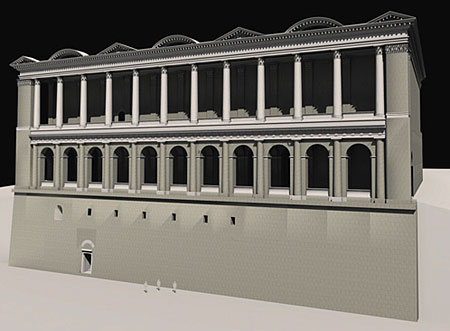
This large and imposing late Republican building filled the space between the two peaks of the Capitoline Hill, extending from the Clivus Capitolinus to the Gradus Monetae and providing a backdrop to the western end of the Roman Forum. As clearly shown on this reconstruction model (courtesy of UCLA's Digital Roman Forum), the building had three stories; the top two were arcades with eleven arches opening to the Forum below. The second storey still survives (though many of the arches have been filled in), but the third storey was torn down by Michelangelo when he built the Senatorial Palace above the ancient structure (as shown in this modern picture). The second storey arches had engaged Doric columns; fragments from the third storey suggest that its columns were Corinthian.
No surviving literary texts name this building; our modern name, "Tabularium," comes from a now-lost inscription found on the site in the fifteenth century, indicating that Quintus Lutatius Catulus, consul of 78 BCE, built a substructionem et tabularium, "substructure and archive." It seems likely that this was the building, though it may have had many other functions besides the storing of public records. Certainly one major function was to provide easy and pleasant passage between the Capitolium and the Arx without walking all the way down to the Forum. The second-storey arcade was a long corridor with an open arch at each end (see reconstruction; the corridor today is closed at both ends). The high arches of the arcade provided spectacular views of the Forum, though these were considerably reduced when Tiberius enlarged the Temple of Concordia and Domitian built the Temple of Vespasian in front of the Tabularium (this reconstruction drawing shows the crowded monuments at the western end of the Forum.